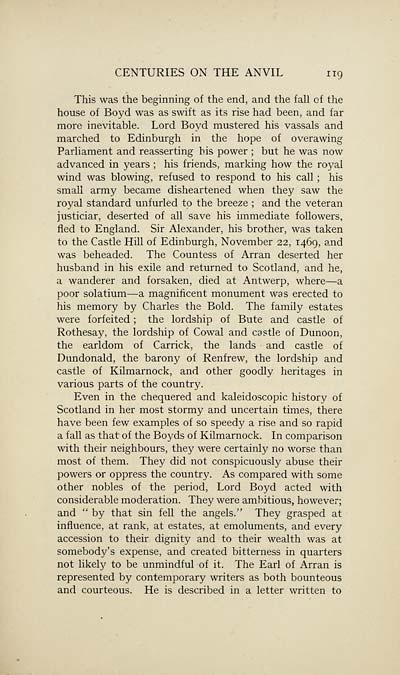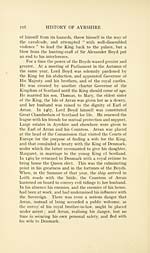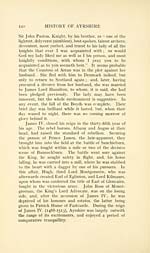Download files
Complete book:
Individual page:
Thumbnail gallery: Grid view | List view

CENTURIES ON THE ANVIL it 9
This was the beginning of the end, and the fall of the
house of Boyd was as swift as its rise had been, and far
more inevitable. Lord Boyd mustered his vassals and
marched to Edinburgh in the hope of overawing
Parliament and reasserting his power ; but he was now
advanced in years ; his friends, marking how the royal
wind was blowing, refused to respond to his call ; his
small army became disheartened when they saw the
royal standard unfurled to the breeze ; and the veteran
justiciar, deserted of all save his immediate followers,
fled to England. Sir Alexander, his brother, was taken
to the Castle Hill of Edinburgh, November 22, 1469, and
was beheaded. The Countess of Arran deserted her
husband in his exile and returned to Scotland, and he,
a wanderer and forsaken, died at Antwerp, where — a
poor solatium — a magnificent monument was erected to
his memory by Charles the Bold. The family estates
were forfeited ; the lordship of Bute and castle of
Rothesay, the lordship of Cowal and castle of Dunoon,
the earldom of Carrick, the lands and castle of
Dundonald, the barony of Renfrew, the lordship and
castle of Kilmarnock, and other goodly heritages in
various parts of the country.
Even in the chequered and kaleidoscopic history of
Scotland in her most stormy and uncertain times, there
have been few examples of so speedy a rise and so rapid
a fall as that of the Boyds of Kilmarnock. In comparison
with their neighbours, they were certainly no worse than
most of them. They did not conspicuously abuse their
powers or oppress the country. As compared with some
other nobles of the period, Lord Boyd acted with
considerable moderation. They were ambitious, however;
and " by that sin fell the angels." They grasped at
influence, at rank, at estates, at emoluments, and every
accession to their dignity and to their wealth was at
somebody's expense, and created bitterness in quarters
not likely to be unmindful of it. The Earl of Arran is
represented by contemporary writers as both bounteous
and courteous. He is described in a letter written to
This was the beginning of the end, and the fall of the
house of Boyd was as swift as its rise had been, and far
more inevitable. Lord Boyd mustered his vassals and
marched to Edinburgh in the hope of overawing
Parliament and reasserting his power ; but he was now
advanced in years ; his friends, marking how the royal
wind was blowing, refused to respond to his call ; his
small army became disheartened when they saw the
royal standard unfurled to the breeze ; and the veteran
justiciar, deserted of all save his immediate followers,
fled to England. Sir Alexander, his brother, was taken
to the Castle Hill of Edinburgh, November 22, 1469, and
was beheaded. The Countess of Arran deserted her
husband in his exile and returned to Scotland, and he,
a wanderer and forsaken, died at Antwerp, where — a
poor solatium — a magnificent monument was erected to
his memory by Charles the Bold. The family estates
were forfeited ; the lordship of Bute and castle of
Rothesay, the lordship of Cowal and castle of Dunoon,
the earldom of Carrick, the lands and castle of
Dundonald, the barony of Renfrew, the lordship and
castle of Kilmarnock, and other goodly heritages in
various parts of the country.
Even in the chequered and kaleidoscopic history of
Scotland in her most stormy and uncertain times, there
have been few examples of so speedy a rise and so rapid
a fall as that of the Boyds of Kilmarnock. In comparison
with their neighbours, they were certainly no worse than
most of them. They did not conspicuously abuse their
powers or oppress the country. As compared with some
other nobles of the period, Lord Boyd acted with
considerable moderation. They were ambitious, however;
and " by that sin fell the angels." They grasped at
influence, at rank, at estates, at emoluments, and every
accession to their dignity and to their wealth was at
somebody's expense, and created bitterness in quarters
not likely to be unmindful of it. The Earl of Arran is
represented by contemporary writers as both bounteous
and courteous. He is described in a letter written to
Set display mode to:
![]() Universal Viewer |
Universal Viewer | ![]() Mirador |
Large image | Transcription
Mirador |
Large image | Transcription
Images and transcriptions on this page, including medium image downloads, may be used under the Creative Commons Attribution 4.0 International Licence unless otherwise stated. ![]()
| Histories of Scottish families > Ayrshire > Volume 1 > (129) Page 119 |
|---|
| Permanent URL | https://digital.nls.uk/95195834 |
|---|
| Attribution and copyright: |
|
|---|
| Description | A selection of almost 400 printed items relating to the history of Scottish families, mostly dating from the 19th and early 20th centuries. Includes memoirs, genealogies and clan histories, with a few produced by emigrant families. The earliest family history goes back to AD 916. |
|---|

